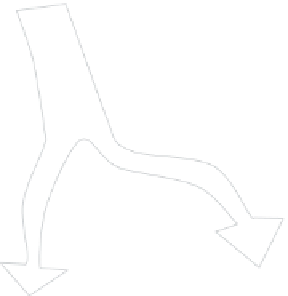Environmental Engineering Reference
In-Depth Information
Upstream
Mining, extraction, and
processing
Raw
materials
Downstream
Smelting and metal
fabrication
Quarrying, open cast,
shaft, and tunnel mines
Rejects, oversize,
debris, etc.
Tips
Tailings and tailing ponds
Wastewater discharge
Acid leachate
characteristic of acid
mine drainage (AMD)
FIGURE 5.1
Illustration of some of the major features associated with mining and natural resource extraction. The example
shown is typical of metalliferrous mining-extraction operations.
potential impacts to the terrestrial ecosystem. In the United Kingdom, for example, more
than 200 years of mining of coal and iron ore left 500 million tonnes of residual waste from
coal and iron and steel manufacturing as sterile waste tips (Barr, 1969). These tips are the
result of the removal of more than 52 million tonnes of coal from the underground. Ground
subsidence, water pollution, and toxic gas emissions are other impacts. Not only do these
tips constitute blights on the landscape but they are also hazards when slide failures occur.
There are historical reports of such failures that have resulted in human casualties. Figure
5.1 shows a simple generic illustration of operations associated with mining and extraction
of metal mineral resources. Individual mineral extraction and/or beneiciation processes
will differ between different types of minerals and their host ores—creating their own
types of stressors and associated impacts. Speciic examples will be discussed in a later
section.
The two principal groups of activities of the natural resource extraction process includes
(1) mining for procurement of host rocks containing the desired ores and (2) extraction and
processing the host rocks to obtain the desired minerals (generally called beneiciation).
As shown in Figure 5.1, the result of these two groups of activities are generation of rejects
and other debris that end up as
heaps
and discharge of tailings slurries and wastewater.
5.2.2 Biohydrometallurgical Processes
Bacterial leaching of metals from mining ores, also called bioleaching, is a full-scale pro-
cess that can be performed by slurry reactors or heap leaching (Figure 5.2). Mining wastes





















































































































































Search WWH ::

Custom Search